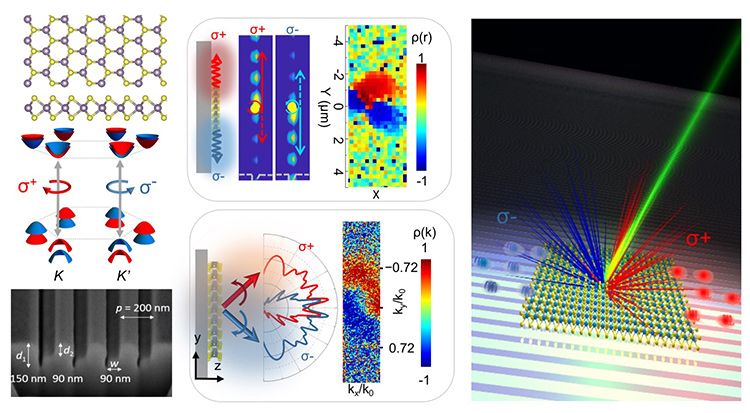 Left: Crystal structure of monolayer transition metal dichalcogenides (top); schematics of the band structure and optical selection rule at the boundary of the Brillouin zone (middle); and SEM image of the cross-section of the asymmetric grooves (bottom). Center: Separation of valley excitons in real space (upper diagram) and of polarized photons in momentum space (lower diagram). Each diagram includes schematic (left), simulation (middle), and experimental results (right). Right: Artist’s illustration of valley exciton separation in real space and polarized emission separation in momentum space. [Adapted from reference 3.]
Left: Crystal structure of monolayer transition metal dichalcogenides (top); schematics of the band structure and optical selection rule at the boundary of the Brillouin zone (middle); and SEM image of the cross-section of the asymmetric grooves (bottom). Center: Separation of valley excitons in real space (upper diagram) and of polarized photons in momentum space (lower diagram). Each diagram includes schematic (left), simulation (middle), and experimental results (right). Right: Artist’s illustration of valley exciton separation in real space and polarized emission separation in momentum space. [Adapted from reference 3.]
Modern electronics is inexorably approaching the limit of Moore’s law,1 inspiring intense research in alternative areas—such as spintronics and valleytronics, in which spins or pseudospins, rather than electronic charges, are used as information carriers. Recent successes in materials science, such as the isolation of atomically thin transition metal dichalcogenides (TMDs),2 provide exciting opportunities to advance these concepts. In work published this year, we demonstrated the coupling of such materials with optical metasurfaces for sorting and controlling excitons for valleytronics.3
TMD monolayers such as molybdenum disulfide (MoS2) often possess a direct bandgap in the visible frequency region characterized by opposite spins at the +K and –K valleys. That characteristic offers a unique platform to control the spin and valley degrees of freedom.4 However, short valley depolarization times and rapid exciton lifetimes in pristine TMD monolayers at room temperature have prevented the application of valley pseudospins in practical on-chip valleytronic devices. To overcome this obstacle, resonant optical nanostructures have been recently suggested as a way to enhance and separate exciton emissions from opposite valleys toward different directions.3–5
In our recent work,3 we demonstrated that valley-polarized excitons can be sorted and spatially separated at room temperature by coupling a MoS2 monolayer with a tailored asymmetric-groove metasurface. The absence of mirror symmetry in the plane perpendicular to the metasurface grooves, combined with spin–valley locking, enables the spatial separation of excitons with opposite valleys.
Our device can further sort photons with opposite helicity from valley-polarized excitons toward different directions. Thus it could operate as a powerful interface between photonic and valleytronic devices. More broadly, our approach can be extended to a wide range of material platforms, enabling the practical use of the valley degree of freedom for information processing and storage at room temperature.
Researchers
Alex Krasnok and Andrea Alù CUNY Advanced Science Research Center, New York, N.Y., USA, and The University of Texas at Austin, Texas, USA
Liuyang Sun, Chih-Kang Shih and Xiaoqin Li, The University of Texas at Austin, Texas, USA
Chun-Yuan Wang, The University of Texas at Austin, Texas, USA, and National Tsing-Hua University, Hsinchu, Taiwan
Shangjr Gwo, National Tsing-Hua University, Hsinchu, Taiwan, and Academia Sinica, Taipei, Taiwan
References
1. L.B. Kish. Phys. Lett. A 305, 144 (2002).
2. S. Manzeli et al. Nat. Rev. Mater. 2, 17033 (2017).
3. L. Sun et al. Nat. Photon. 13, 180 (2019).
4. J.R. Schaibley et al. Nat. Rev. Mater. 1, 16055 (2016).
5. S.H. Gong et al. Science 359, 443 (2018).
